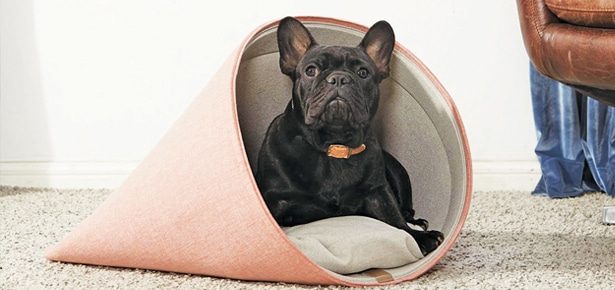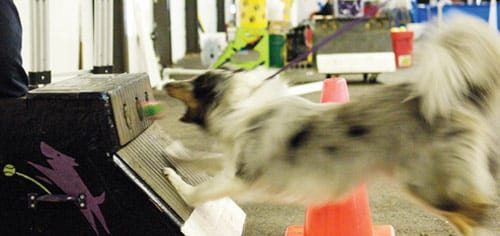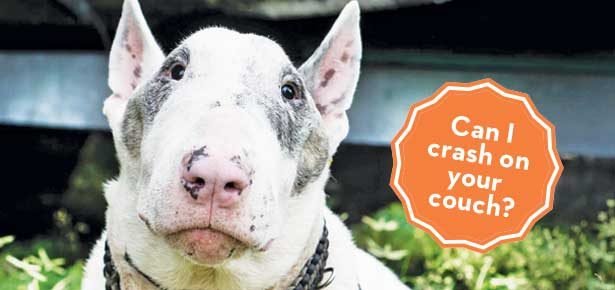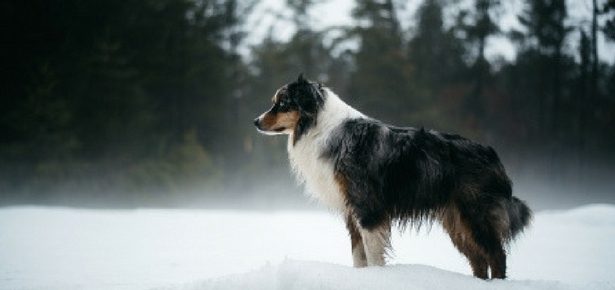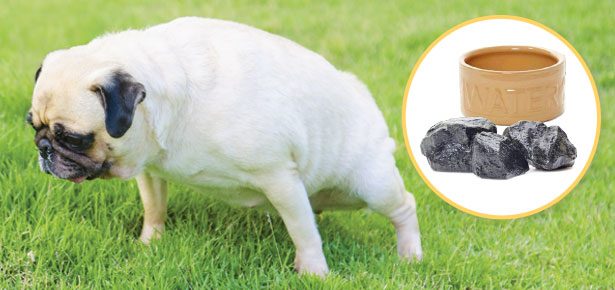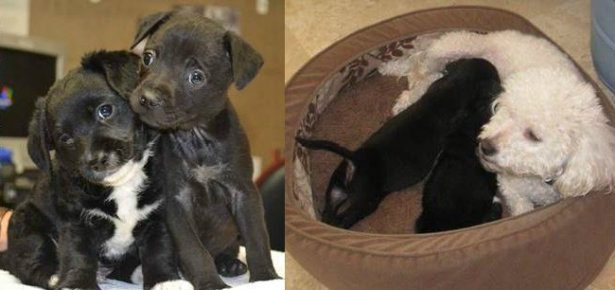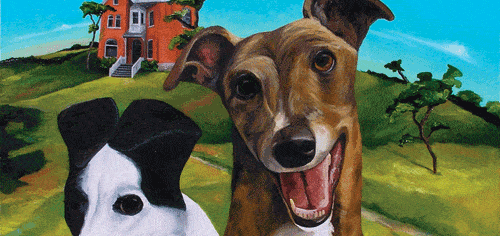
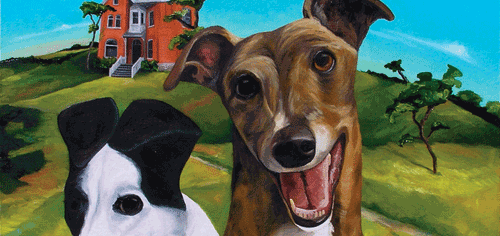
Sitting Pretty: Dog Portraiture
Pet portraiture, once solely a concern of aristocrats, is now available to us ordinary mutts, too.
Skully the Doberman Pinscher is digging up carrots again to feed the rabbits. The bunnies race out of their coop and eagerly skitter over Skully’s large paws to rest against his sleek, ebony side and chew the autumn-orange roots in sharp, rapid bites of contentment.
Is this fact or fiction? Most dog owners will recognize it as fact, for animals reveal themselves to humans in interesting ways and Skully’s naps with the rabbits illustrate his peaceful, gentle nature. Tales like this reveal character and become the foundation for how portrait artists interpret their subjects. Through stories of animal behaviour, artists discover the spirit of the creatures, and then transform the tales into works of art.
Artist Marion Morrison notes that while it might not always be possible to meet with the pet that she’ll be painting, the owner will have stories that reveal the pet’s personality. For Marion, personality is conveyed in a whimsical style through vibrant colours like deep purples, aquas, and canary- and mustard-yellows. And the portrait becomes “not a photographic rendition, but a creative interpretation… [where] the relationship you have with your dog is reflected in the painting.”
Artists Judith Madsen and Linda O’Neill both work primarily from photographs. Madsen feels that it’s “impossible to work with live animals [and] photographs provide a means of interpretation.” In watercolour there is a layering of colour to create a texture that seems to embody character. With pets, owners’ stories again help with the artistic process. If people tell Madsen that the dog is goofy, then she’ll paint the eye with a twinkle and add a mischievous facial expression. O’Neill agrees that the details tell stories that are “essential for capturing the essence of the dog.”
Artist Lisa Graziotto will try to meet and play with her subjects, and listen to the memories owners have about their furry “offspring.” Working from photos, mental notes and her experiences with the animals, she will then go to her studio to produce works that tell a story about the subject. Examining Graziotto’s work, it is easy to see the importance of these stories. Her rich and vibrant “portraits with attitude” make much use of details and background information.
If we trace the origins of portraiture, we see that “telling a story” is the way artists originally worked with portrait subjects. Take, for example, Jan van Eyck’s famous marriage portrait, Portrait of Giovanni Arnolfini and His Wife (1434, National Gallery, London), in which intricate details of the work, such as a statue of St. Margaret, patron saint of childbirth, a small dog at the bride’s feet, and an open bed in the background, symbolize the act of marriage and the importance of fertility at that time for a marriage. “It’s the background, that tells the story,” Graziotto notes. Years from now, Skully’s family will look at his portrait and recall his propensity for chewing carrots with the rabbits in the back yard.
At the same time, one must not confuse the art of animal portraiture with human portraiture. As Lisa Graziotto notes, humans have expectations that the artist may or may not recognize. We may see ourselves in an entirely different way from that in which the artist sees us. As such, portrait artists must deal with the tension between client and finished painting. Perhaps this is why human portraiture seems to have gone out of fashion. With the exception of political and royal figureheads, portraiture is not as common as it once was.
Animal portraits, on the other hand, seem to be enjoying a comeback.
The history of animals as artistic subject matter goes as far back as the bison paintings in the Lascaux caves in Dordogne, France. Artist Wendy Grossman notes, “[Since] the dog has shared its life with humans, from prehistoric times to now, they have been depicted in carvings and paintings in early Egyptian, Greek, Mesopotamian and Roman art.”
While the Lascaux paintings date back to 15,000 B.C., and while animals may have appeared in paintings throughout the ages, it wasn’t until the 19th century that animal portraiture became immensely popular. To a great extent, this was due to the works of artists such as Rosa Bonheur, Sir Edward Lanseer and Arthur Wardle.
Rosa Bonheur’s work was notable for a number of reasons. Not only was she a woman painting at a time when only men could be educated in the fine arts, but she applied to the French government for permission to wear trousers so that she could frequent traditionally male places such as stables and horse races so she could study her subjects first-hand. This clearly paid off, for her work seems to vibrate with the vitality and intense energy of the animals. While Bonheur painted a vast range of animals, from lions to cattle to sheep to dogs, it was her 1853 painting The Horse Fair that attracted the attention of Queen Victoria and achieved her financial and popular success.
Scottish painter Sir Edward Lanseer was also a favourite of Queen Victoria. When he first exhibited at the Royal Academy in 1816, much was made of his ability to take animal subjects and parody human behaviour. Perhaps this is because if we truly understand animals, we find familiar traits in them. The sparkle in an eye, a sheepish grin, and a deep sigh before turning around and settling down for the night are characteristics not only of dogs, but also of humans.
While artists like Lanseer and Bonheur may have focused on domestic animals, artists like Arthur Wardle frequently turned to wild members of the animal kingdom. Although Wardle was famous for painting dogs for royal families, he also infused mythology and literature into wild animal
subjects. The Lure of the North (1912) illustrates a mermaid playing her lyre, surrounded by polar bears and seagulls. Although artists today work in a variety of styles that are difficult to ascribe to one school or another, Wardle’s work, distinctly Romantic, is not dissimilar to the soft, gentle hues found in Judith Madsen’s work.
Perhaps it is the romantic appeal of pet portraiture that is part of the reason for its current resurgence. When animal portraiture was thriving in the 1800s it was largely due to aristocratic values. A lord was hardly properly represented in oil unless surrounded by his hounds, and certainly no hunting portrait would be complete without the dogs to chase the fox or hind. Portraiture at this time was part of a family’s holdings and heritage, and a painting by a popular and valued artist, especially one that the Queen had endorsed, was a valuable commodity. Paintings were also a way of immortalizing the subject matter and making future generations aware of, and pay reverence to, the past.
Respect for the past declined in the wake of the Industrial Revolution. Not only was there a rising middle class that lacked the aristocrats’ concern for bloodlines and thus the need for portraiture, but the emphasis on property shifted more to coin and liquid property, such as real estate and factory ownership, rather than family heirlooms. Further, as this was the beginning of the age of mass production, prints of famous works began to become available. Why commission the Mona Lisa if you could buy a copy for a tuppence? While the intrinsic value of individual paintings may not have declined, the drive to purchase or commission them died down.
So why is pet portraiture on the rise? As Wendy Grossman notes, “the rising trend of dog portraiture is a natural extension acknowledging the current bond between [dogs and humans].” Marion Morrison points out that perhaps it’s simply the “emotional appeal of the pet [combined with] a piece of art.” Or, they’re “doing it because they love their dogs” and having a portrait of the animal long after the animal is gone means that emotional connection is made eternal through the portrait. Linda O’Neill feels that perhaps it’s “because of the overabundance of technology … people hunger to get back … [to] a deeper connection to animals and to the earth. The deep connection we feel for our pets keeps us connected to what is still good in life. Unconditional love, acceptance, fun and the enjoyment of simple times.”
So what should one look for if seeking to commission a pet portrait? Look at the previous works of the artist and determine which styles you prefer. How does the artist work with the animals? If the artist likes to work with the personality of the pet, have plenty of stories on hand to educate the artist about the pet’s life. Consider the ways in which you would like to see your pet represented and then try to match your ideal with previous portraits the artist may have done.
Thomas Aquinas said that three qualities are required for great art: wholeness, harmony and radiance. Wholeness and harmony have to do with the details of the composition and how they work together, while radiance is the spirit of the artist that suffuses the work and then refines itself out of existence. In the case of pet portraiture, one might reverse this and say that it is the spirit of the animal that passes into the work and refines itself into existence—immortalized on canvas.
Comments (1)
Join the newsletter and never miss out on dog content again!
"*" indicates required fields
By clicking the arrow, you agree to our web Terms of Use and Privacy & Cookie Policy. Easy unsubscribe links are provided in every email.
